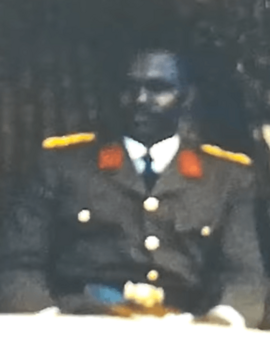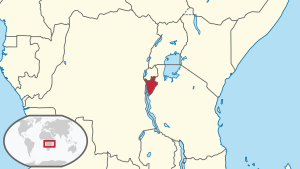Michel Micombero facts for kids
Quick facts for kids
Michel Micombero
|
|
|---|---|

Micombero as prime minister in 1966, at the coronation ceremony of King Ntare V
|
|
| 1st President of Burundi | |
| In office 28 November 1966 – 1 November 1976 |
|
| Prime Minister | Albin Nyamoya (1972–73), then position abolished |
| Preceded by | Ntare V, as king Himself, as prime minister |
| Succeeded by | Jean-Baptiste Bagaza |
| 8th Prime Minister of Burundi | |
| In office 11 July 1966 – 28 November 1966 |
|
| Monarch | Ntare V |
| Preceded by | Léopold Biha |
| Succeeded by | Himself, as president |
| Personal details | |
| Born | 26 August 1940 Rutovu, Ruanda-Urundi (modern-day Burundi) |
| Died | 16 July 1983 (aged 42) Mogadishu, Somalia |
| Political party | Union for National Progress (UPRONA) |
| Spouse |
Adèle Nzeyimana
(m. 1965) |
| Alma mater | Royal Military Academy University of Somalia |
| Military service | |
| Allegiance | |
Michel Micombero (born August 26, 1940 – died July 16, 1983) was a Burundian politician and army officer. He ruled Burundi for about ten years, from 1966 to 1976.
He was the last Prime Minister of the Kingdom of Burundi from July to November 1966. After that, he became the first President of the Republic of Burundi in November 1966. He remained president until he was removed from power in 1976.
Micombero was from the Tutsi ethnic group. He started his career as an officer in the Burundian military when Burundi became independent in 1962. He became well-known for helping to stop an attempt to overthrow the government in October 1965. This attempt was made by Hutu soldiers against the Tutsi-led monarchy.
After this event, Micombero himself led two more attempts to take power in 1966. The first one in July put a new king on the throne and made Micombero the prime minister. The second one in November ended the monarchy completely. This made Micombero the first president of the new Republic of Burundi.
Micombero led a country where only one political party was allowed. His government took control of many parts of the country. He also tried to keep Burundi neutral during the Cold War. In 1972, a challenge to his power led to terrible violence against the Hutu people. Around 100,000 people, mostly Hutus, were killed. His rule ended in 1976 when another army officer, Jean-Baptiste Bagaza, took over. Micombero then went to live in Somalia, where he died in 1983.
Contents
Biography
Early Life and Military Training (1940–1962)
Michel Micombero was born in Rutovu, Burundi, on August 26, 1940. At that time, Burundi was under Belgian rule. His parents were farmers from the Hima group, which is part of the larger Tutsi ethnic group.
Micombero went to Catholic mission schools in Burundi. In 1960, he joined the military, which was being formed for Burundi's independence. He was sent to Belgium to train as an officer at the Royal Military Academy in Brussels. In March 1962, he became a second lieutenant. When Burundi became independent in July 1962, he was a captain. In November, he became an assistant commander of the Burundian National Army.
Rise to Power (1962–1966)

After Burundi gained independence, King Mwambutsa IV tried to balance the interests of the Tutsi and Hutu groups. In 1963, Micombero joined the UPRONA party. This party was mostly Tutsi but also tried to include Hutu members. In June, Micombero became the Minister of National Defense, leading the military at just 23 years old.
In October 1965, some Hutu soldiers tried to overthrow the king. Their attempt failed, and King Mwambutsa IV went into exile. Micombero led the effort to stop those who tried to take over. On November 9, 1965, he married Adèle Nzeyimana.
In July 1966, another attempt to take power happened. This time, the king's son, Ntare V, became the new king. On July 8, Ntare removed the prime minister and suspended the constitution. The next day, he asked Micombero to form a new government. On July 12, Micombero became Prime Minister and Minister of Defense.
However, tensions grew between the government's soldiers and the new king. On November 28, 1966, while King Ntare was visiting another country, Micombero led a military takeover. He removed the king from power, ended the monarchy, and announced that Burundi was now a republic. Micombero then became its first President.
Leading Burundi (1966–1976)

As president, Micombero declared that UPRONA was the only legal political party. His government, which was essentially a military rule, took control of all the country's institutions and media. He used ideas from different political systems to guide his rule. During the Cold War, he was able to get support from both communist and Western countries.
Micombero became increasingly worried about plots against his government. There were attempts to remove him from power in 1969 and 1971. His support mainly came from Tutsi people in certain parts of Burundi.
In April 1972, a rebellion started among the Hutu people in the south. This led to a period of terrible violence. Around 100,000 people, mostly Hutus, were killed. The former king, Ntare, who was said to have led the rebellion, was also killed. After this crisis, Micombero introduced a new constitution. This allowed him to run for another seven-year term as president. He also helped create a group for economic cooperation with Rwanda and Zaire (now the Democratic Republic of the Congo).
In November 1976, opponents led by Colonel Jean-Baptiste Bagaza successfully took over Micombero's government. Micombero was arrested, and Bagaza became the new president. Bagaza, also a Tutsi, tried to make some improvements for the Hutu majority. He also worked to modernize Burundi before he was removed from power in 1987.
Life in Exile and Death (1977–1983)
Micombero was sent out of Burundi in 1977. He went to live in Somalia, which was then ruled by his friend, dictator Siad Barre. He earned a degree in economics from the University of Somalia in 1982. Michel Micombero died from a heart attack in Mogadishu, Somalia, in 1983.
See also
 In Spanish: Michel Micombero para niños
In Spanish: Michel Micombero para niños

